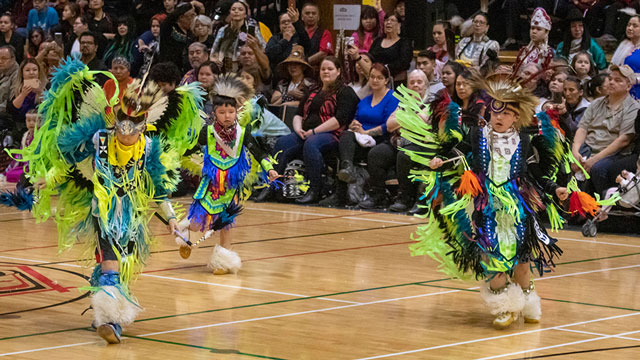At Hobiyee 2020, dance groups from all around British Columbia and even a group from Alberta came to share in the celebration.
“Step back into time. Everything that I shared was something that was instilled in me when I was a very young kid about eight years old when I heard these songs. They were all shown to as the Sim’oogit who owned them,” said Gibuumlaxdaaw, the director of the Gitlaxt’aamiks Ceremonial Dancers
Nisga’a villages come together to celebrate Hobiyee – the start of a new harvest season.
The celebration is filled with song, dance language and feast.
“So here we are in 2020 in Gitlaxt’aamiks celebrating who we are as a people, Indigenous people, the first people of this land – That’s who we are, ” Hereditary Chief Hleek, also known as Joseph Gosnell Sim’oogit said.
Hobiyee took place in February in Gitlat’aamiks; their dance group is celebrating their 50th anniversary.
When the moon is shaped like a wooden spoon and its position aligned with the brightest star it let people of the area know the harvest season arrived.
“The moon rising tells us that the eulachon has arrived. The first resource that comes back from the ocean and following that the moon calls all the different species of salmon to our land,” said Gosnell.
William Moore or Sim’oogit Duuk of the Nisga’a village Laxgalts’ap shared the history of trading taking place on the Nass River. He remembered reading accounts of Hudson Bay traders seeing hundreds of canoes on the Nass River when the eulachon arrived. The eulachon is a small fatty fish, a staple in the diet of many communities on the Pacific Coast
“When the eulachon arrived the people arrived along with the other resources that followed the eulachons. In this case it would be the mammals; the seals, sea lions seagulls, ducks, eagles you name it they are all after the same thing. Then, the people arrive,” shared William Moore.
Some people would arrive for the harvest or trading very destitute. Still ready to trade goods in abundance from their communities for eulachons or eulachon grease.
In the old days, people travelled hundreds of kilometres by canoe or trail.
“We have to remember in those days there were no transportation routes except for grease trail. There was no highway, there were no vehicles. On the trail you walked and on the canoe you paddled,” said Moore.
Coming together as one allowed four Nisga’a villages to sign BC’s first modern-day treaty in 1997. Gosnell was a key player in that fight. He pushed for the unity on display at Hobyiee for Indigenous communities across the country.
“I would like to encourage our people, our leaders, to bring our peoples together to speak as one voice. Not a dozen voices, not half a dozen voices, one voice that is what is needed,” said Gosnell.
Months before Hobiyee young people get excited to train for the dance performances.
Sim’oogit Luudisdoos Harry Moore started the dance group in Nisga’a Village Gingolx 40 years ago.
He shares the secrets passing on the history of the land and language with each song.
“When we’re singing, every time before the song starts before they start singing I tell a little background in it. I tell them what happens in there,” shared Moore.
Gibuumlaxdaaw who put on a show in his beautiful regalia, reflected on the power of Hobiyee.
“Seeing everybody out there and feeling that energy, that’s what this was all about. To be able to show everybody what we did 500 years ago, and what we did 1000 years ago. A lot of our songs go back 10,000 years.”
Dance directors, matriarchs and sim’oogits were proud of the young people’s enthusiasm in training and performance of their songs.
This transference of knowledge from elders to youth has been key in preserving Indigenous history across the county.
Peter Azak, a co-director of Four Crest Dancers from Nisga’a village Gitwinksihlkw, recalled learning at a young age.
“We were taught by our grandfathers who led when we were young. A lot of the songs are in our hearts and while we’re practicing and while we’re singing them, they become a part of the younger generations’ hearts as well,” shared Azak.
Throughout the year, dance groups commit to learning weekly with youth, eventually transitioning into the mentorship roles as they grow with the culture.
“We have come through the system as dancers, as drummers and singers and now one of the leaders of the Four Crest Dance group as directors. To watch our youth now take those roles, which we once had as kids has been amazing. Their voices are sometimes more powerful than ours,” shared Anthony Moore who is the co-director of Gitwinksihlkw Four Crest Dancers.
Hobiyee shines a bright light for elders and youth to display what has been passed down.
“Giving the young people that chance to learn the language because we don’t want to see it fade away. Today our language is here. If you really look at it when we isolated, our language was way up here,” said Harry Moore.
Next year when another harvest season arrives, another Nisga’a Village will take centre stage.













